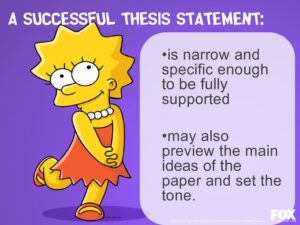When asking a student to write a paper in high school, how many teachers pass out a paper that looks like the following:
Research Project: 1. Cover; 2. Typed paper with a. Title Page; b. Contents; c. Footnotes; d. Bibliography; e. Visuals? Your thesis statement is due by next week.
Most students haven’t been taught the research strategies that make for “real” research. If your high school has a media teacher (librarian in the old vernacular), it would be beneficial to utilize this teacher to help your students learn a skill that will help them throughout their academic careers.
- What is a thesis statement? How do you decide on one?
Without systematic teaching a student will end up with a topic that is too broad or too narrow. If the school doesn’t have a media teacher who can help kids decide on a topic and/or a subtopic, the student is left wondering where to start and how to write.
As an example, let’s say a student has chosen a topic on “water.” There are tremendous amounts of information on the broad topic so the student needs to know how to narrow the topic to a level that is doable.
- Without practical experience how will the student “understand” how to narrow a topic?
The teacher must teach him or her to look in the encyclopedia under the topic. Show how water has various subtopics that are potential research areas. Or if they choose a topic that is too narrow, they won’ be able to find enough information.
For example, interior decorating during George Washington’s Presidency might yield too little information and the student may have to broaden the topic to interior decorating during the 1700s.
Most teachers need to frontload information and strategies for students. Here are a few ways to help students write a thesis statement:
Choose a Topic:
1. Find a topic in the grade-level textbook. This will help the student; pick something that is readable at correct grade level and at a level the student will understand. Special consideration should be given to English language learners to help them be successful. For example, they may not be at grade level in reading
2. Some students may have after school jobs or living in an area that is not safe to walk to the public library, and the school library is their only research option. The teacher should be sure that the student can find enough information from different medias (print, computer) is available at the school library.
3. Use an encyclopedia to broaden or narrow a subject.*(this is important so that the students don’t get bogged down with too much information or too little information.
These few steps will help the student to be able to write a thesis statement.
A thesis statement tells what subject the student will research and what s/he are going to investigate in depth.
There is so much more to research than just the thesis statement. Students will enjoy research so much more if they have the tools to do it in a systematic way. The lack of research skills shows up when the students tend to plagiarize because they don’t know how to approach a subject.
These few tips will help your student become a lifelong learner which is part of our goals as educators cover.

